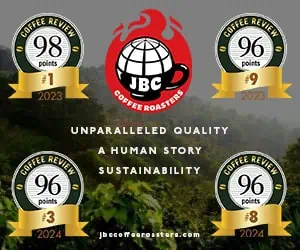LATEST REVIEWS
We have published thousands of coffee reviews and espresso reviews since 1997. The reviews below appear in reverse chronological order by review date. Older reviews may no longer accurately reflect current versions of the same coffee. To search for a specific roaster, origin or coffee use the Advanced Search Function.
About half the cups of this low-toned but forceful blend hint at the taste defect called bagginess, a flat, ropey taste green coffee acquires when it has not been fully cured before shipping or stored properly. The cups free of defect display a subdued intensity powered by a spicy, edge-of-astringent pungency.
Restrained, low-toned, rather full-bodied, but not flat. In fact, alive with understated nuance: some tobacco tones, a full, dry spice impression that could be called chocolate; perhaps a hint of fruit or wine in the round finish. The aftertaste leaves a balanced memory of chocolate sweetness and dry tobacco.
An unusually light-bodied, high-toned Guatemala, distinguished by a clean, bright acidity and sweet flowers in the finish. A hint of sweet spice or perhaps chocolate-toned fruitiness resonates under the flowers.
Some cups display a muted but disturbingly hard off-taste, probably a fault in the drying. The clean cups are low-key, sweet, with a pleasant, round earthiness and excellent resonance or dimension.
Some cups of the sample are marred by a slight but distracting hardness, probably a fault in either drying or storage of the green coffee. The untainted cups are gentle, chocolaty and sweet, with a touch, perhaps, of flowers.
A natural, vanilla-toned sweetness distinguishes a low-key but lively profile. Nut and spice notes complicate the vanilla sweetness in the aroma, but by finish and aftertaste the vanilla gently (and pleasingly) dominates. Little range or dimension; the vanilla is the main act.
Floral, fruity tones dominate, modulating to a sweet spiciness in the finish. The fruit reasserts itself in the long aftertaste. The fruitiness flirts with the over-the-top lush taste called ferment, but to my palate remains on the fresh, pleasing side of the fruit-ferment line.
Plenty of nuance and long, complex development. An authoritative, dry-spice pungency opens in a matrix of shadow sweetness. A touch of vanilla in the finish, dry chocolate in the aftertaste. As the cup cools the spice softens and sweetens deliciously.
The dry, bright sensation called acidity dominates both nose and cup here. It is a pure acidity, without fruity complication or sweet reservation: clean and abstract. Acidity energizes a profile with plenty of sensation in mid range, but with little at the top and only a hint of pruny underpinning.
The floral perfumes are high-toned and exquisite in the aroma and overwhelmingly fragrant in the cup. Eventually a sweet, bright-toned coffee emerges from behind all the flowers. Owing to the floral lift the body reads as lightly buoyant rather than thin.
A gentle cup that seduces rather than imposes. Saved from the ordinary by a soft, rounded complexity and impressive dimension. Warmly pungent tones, faintly tobaccoish or herby, soften toward chocolate in the finish.
A fine example of the French-roast archetype. The carbon notes, as integral to French roasts as smoky notes are to Scotch whiskey, are discreet. The main taste complex here is sweet vanilla, floating above a dry, light pungency. Carbon notes prevail in the aftertaste, though a persistent low-toned sweetness gives them a run.
A fresh, clean, delightfully natural sweetness is balanced by a drier but still fruity pungency. A fine and distinctive coffee, though memorable more for what it gives out front than what it insinuates. The profile is immediate and pleasing rather than deep.
This delightfully gentle coffee is soft, brightly (and lightly) acidy, slightly floral. The aftertaste is as clean as white clapboard, with a lovely vanilla/floral burst, then a memory of pure sweetness. Not much power or depth here, but with a coffee this chastely bright and sweet who cares.
The superb oxymoron of this coffee, powerfully sweet yet sharply pungent, is at its best in aroma and in finish, when the pungent tones soften to a distinct and pleasing spice. Rich, clean aftertaste; medium to light body.
Distinct fruity chocolate tones, cherryish and round, are balanced by a tobaccoey dryness. When the coffee is hot the chocolate-fruit tones are fresh, complex, and thrilling. As the cup cools the tobacco tones intensify and turn slightly (though cleanly) astringent.
An extraordinarily clean, elegant Mocha-Java. The contribution of the two Ethiopian coffees is brightly fruity, floral and exhilaratingly fresh. The Java mostly stays out of the way, contributing a slight pungency to balance the Ethiopias' high-toned sweetness. The light body could be taken as a fault, but I found it more exhilaratingly weightless than disappointingly thin.
Complete and classic. Dry and acidy, but the acidity is held inside a deep, resonant matrix and complicated by richly wine-tinged fruit tones. Sweetens exquisitely in the finish. The medium body is smooth and buttery.
Floral, berry-like, high-toned and vivacious, this striking coffee displays less winy authority than many Kenyas but greater charm. Light-bodied but not light-weight: gives us a sort of levitating richness.
This coffee manifested some brightness and acidity in the cup, which probably accounted for a higher rating than one would expect given that several panelists complained of a background shadow or taint. I called the problem a "slight, high, hard fruitiness." Another cupper identified it as grassiness; another detected a "rubbery" taste; still another concluded the coffee was "faded." Not much consensus in those descriptions, but clearly something was off. Two of us noted that the profile tended to vary from cup to cup, with some cups bright with a floral or fruit-toned acidity, and some dulled by the elusive taint.












